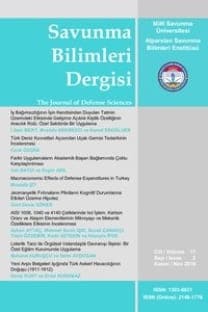Kurumsal ve teknik çevre ayrımında yönetim kurulu fonksiyonu ve yapısı: kuramsal bir çerçeve
Board function and structure in the dinstinction of institutional and technical environment: a theoretical framework
___
- Boeker, W. ve Goodstein, J. 1991. Organizational performance and adaptation: Effects of environment and performance on changes in board composition. Academy of Management Journal, 34: 805-826 34
- Daily, C. ve Dalton, D. 1993. Board of directors leadership and structure: Control and performance implications. Entrepreneurship Theory and Practice. 17: 65-81.
- Daily, C. M. 1996 Governance patterns in bankruptcy organizations, Strategic Management Journal, 17: 355-375.
- Dalton, D. R., Daily, C. M., Ellstrand, A. E., Johnson, J. L. 1998. Meta-analytic reviews of board composition, leadership structure, and financial performance. Strategic Management Journal, 24: 269-290.
- Dalton, D. ve Kesner, I. 1983. Inside/outside succession and organizational size: The pragmatics of executive replacement. Academy of Management Journal, 26. 736-742.
- DiMaggio, P. J. ve Powell, W. W. 1983. The iron cage revisited: Institutional isomorphism and collective rationality in organizational fields. American Sociological Review 48(2): 147-160 36
- Donaldson, Lex. 1995. American anti-management theories of organizations: a critique of paradigm proliferation. Cambridge. Cambridge University Press.
- Fennel,M,E. ve Alexander,J,A. 1987.Organizational boundary spanning in institutionalized environments .Academy of Management Journal. 30(3): 456-476.
- Forbes, D. & Milliken, F. 1999. Cognition and corporate governance: Understanding boards of directors as strategic decision making groups. Academy of Management Review, 24: 489-505.
- Goodstein, ,J.,Gautnam,K., Boeker,W. 1994. The effects of board size and diversity on strategic change. Strategic Management Journal. 15(3):241-250.
- Hirsch,P,M. 1975. Organizational effectiveness and the institutional environment. Administrative Science Quarterly. 20(3): 327-344.
- Huse, M. 1990 Board composition in small enterprises, Entrepreneurship & Reg ional Development, 2: 363- 373.
- Huse, M. 2000. Boards of directors in SMEs: A review and research agenda. Entrepreneurship and Regional Development, 12: 271-290.
- Kerr, N,L. Ve Tindale,R,S.2004. Group performance and decision making. Annual Review of Psychology. 55:623-655.
- Kesner,l,F.1988. Directors' characteristics and committee membership: An investigation of type, occupation, tenure, and gender.Academy of Management Journal.31(1): 66-84.
- Li,J.1994. Ownership structure and board composition: A multi-country test of agency theory predictions Managerial and Decision Economics. 15(4): 359-368.
- Luoma, P.^and Goodstein, J. 1999. Stakeholders and^çprpgrate boards: institutional influences on board composition and structure, Academy of Management Journal, 42: 553- 563.
- Lynall, M,D., Golden,B,R.,Hillrnan,A,J. 2003. Board composition from adolesence to maturity. Academy of Management Review,28(3): 416-431.
- Meyer J. W. & Rowan B. 1977. Institutionalized organizations: formal structures as myth and ceremony. American Journal of Sociology, 83: 340-63
- Milliken, F. J. and Martin, L. L. 1996. Searching for common threads: understanding the multiple effects of diversity in organizational groups, Academy of Management Review, 21: 402-433.
- Osborn,R,N.ve Hunt,J,G.1974. Environment and organizational effectiveness. Administrative Science Quarterly. 19 (2):231-246.
- Palmer, D, A. Ve Biggart, N, W.2002. Organizational institutions.Joel,A,C.Baum (Der) The Blackwell Companion to Organizations. Oxford:Blackwell, 259,280.
- Pearce, J. A. and Zahra, S. A. 1991 The relative power of CEOs and boards of directors: associations with corporate performance, Strategic Management Journal, 12:135-153.
- Pearce, J. A. ve Zahra, S. A 1991. The relative power of CEOs and Boards of Directors: associations with corporate performance. Strategic Management Journal, 12(2): 135-153.
- Pettigrew, A. 1992. On studying managerial elites. Strategic Management Journal, 13: 163-183.40
- Pfeffer, J. & Salancik, G. 1978. The External Control of Organizations: A Resource Dependence Perspective. New York: Harper & Row.
- Pfeffer, J. 1972. Size and composition of corporate boards of directors. Administrative Science Quarterly, 21: 218-228.
- Pfeffer, J. 1973 Size, composition, and function of hospital boards of directors: a study of organization environmental linkages, Administrative Science Quarterly, 18: 349-364.
- Scott, W. R. 1992.0rganizations Rational Natural and Open Systems. Thousand Oaks, CA: Sage Publications.
- Smith, K,G.,Mitchell,G,R., Summer,C,E. 1985. Top level management priorities in different stages of organizational life cycle. Academy of Management Journal. 28(4):799-820.
- Tolbert, P. S. 1985. Institutional environments and resource dependence: Sources of administrative structure in institutions of higher learning. Administrative Science Quarterly, 30:1-13.
- Üsdiken, B. 2006. Kaynak Bağımlılığı Kuramı. A.S. Sargut ve Ş. Özen (Der). Örgüt Kuramları,Ankara,İmge
- Yıldırım, Ö ve Üsdiken, B. 2005. Boards of directors in firms within family business groups: Evidence from Turkish 'Holding' companies. 21. EGOS Kollokyumu, Berlin, 30 Haziran-2 Temmuz 2005.
- Zajac, E. J. & Westphal, J. D. 1996. Who shall succed? How CEO/Board preferences affect the choice of new CEOs. Academy of Management Journal, 39:64-90.
- ISSN: 1303-6831
- Yayın Aralığı: Yılda 2 Sayı
- Başlangıç: 2002
- Yayıncı: Milli Savunma Üniversitesi Alparslan Savunma Bilimleri ve Millî Güvenlik Enstitüsü
SAVUNMA PLANLAMASININ EKONOMİYE ETKİLERİ VE SAVUNMA BÜTÇELERİ
RF'nin Avrupa Güvenliğine yönelik yeni önerilerinin AGİT ve AKKA bağlamında değerlendirilmesi
Savunma Planlamasında Belirsizlik ve Belirsizlikle Başa Çıkmada Esnek Yaklaşımlar
Cem Harun MEYDAN, Akif DEMİREL
PERAKENDE SEKTÖRÜNDE TEDARİKÇİ SEÇİMİNİN BULANIK AHP İLE GERÇEKLEŞTİRİLMESİ
KURUMSAL VE TEKNİK ÇEVRE AYRIMINDA YÖNETİM KURULU FONKSİYONU VE YAPISI: KURAMSAL BİR ÇERÇEVE
Perakende sektöründe tedarikçi seçiminin bulanık AHP ile gerçekleştirilmesi
RFânin Avrupa Güvenliğine Yönelik Yeni Önerilerinin AGİT ve AKKA Bağlamında Değerlendirilmesi
Örgütsel Özdeşleşmenin Sinizm ve İşten Ayrılma Niyeti ile İlişkisi Üzerine Bir Araştırma
Mustafa POLAT, Cem Harun MEYDAN
Savunma planlamasının ekonomiye etkileri ve savunma bütçeleri
Kurumsal ve teknik çevre ayrımında yönetim kurulu fonksiyonu ve yapısı: kuramsal bir çerçeve
